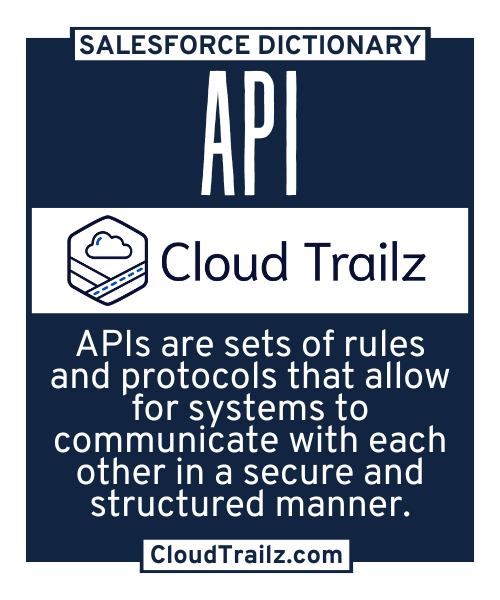
API
Overview
An API, Application Programming Interface, is a set of rules/protocols that allow different software applications to communicate with each other.
How Are APIs Used?
They act as an intermediary, enabling developers to access specific features or data from another application without having to understand the internal workings of that application. In Salesforce you will primarily interact with: REST, Soap, Bulk, Streaming, Metadata and Tooling API’s.
REST
REST uses standard HTTP methods (GET, POST, PUT, DELETE) for CRUD operations. Commonly used for accessing Salesforce data and integrating with other systems.
SOAP
SOAP uses XML for requests and responses. Often used in backend integrations at an enterprise level, providing complex security and transaction abilities.
Bulk
Designed for loading and deleting large volumes of data asynchronously. It supports both CSV and JSON formats. Useful for data migrations and bulk updates where system performance could be an issue.
Streaming
Allows for real-time notifications of changes in Salesforce data. It uses the Bayeux protocol and is built on the CometD framework. Ideal for real-time updates, such as dashboards or monitoring tools.
Metadata
Used to manage customizations and configurations in Salesforce, including creating, updating, and deleting metadata components (like custom objects, fields, etc.). Useful for deployment processes and managing configuration changes across different Salesforce environments.
Tooling
Provides the ability to manage and manipulate metadata in a Salesforce org. It’s often used for development and debugging purposes. Useful for building custom development tools and integrating with IDEs.
Best Practices
Implementing API’s with Salesforce is an extremely helpful tool, but it is also one that needs to be carefully implemented. Choosing the right type is the first step to success.
When designing the integration, using OAuto 2.0 for access as well as the most strict security profile possible for the integration user is also key when thinking about authentication and access.
Knowing limits is helpful, understanding errors, pause and retry limits will ensure you don’t break the integration. Optimize SOQL queries, streamlining calls like GET and FOR that could iterate over thousands of records in a single transaction.
Implementing error handling is also crucial to ensuring that one bad record or transaction doesn’t ruin an entire integration.
Always test thoroughly (security and configuration) to ensure you don’t inhibit functionality or expose too much data and create a security risk.
Common Use Cases of API
| Use Case | Roles | Scenario | Outcome |
|---|---|---|---|
| Rest API | Developers | System Integration |
|
| Bulk API | Admins | Data Uploads |
|
Common Challenges
#1 – API not able to retrieve or update data in Salesforce
Resolution
Find the Connected App or Integration user and verify settings for objects/records you are trying to connect with
#2 – API disconnects frequently or won’t connect at all
Resolution
Verify Oauth configuration and ensure Certificates are up to date
#3 – API begins to fail and no explanation is given in logs
Resolution
If managed in Salesforce, ensure proper error handling is added throughout job to enable debugging. If 3rd party, reach out to vendor for assistance
Trailhead Modules
| Module | Description | Estimated Completion Time | Difficulty Level |
|---|---|---|---|
API Basics |
|
~25 mins | Beginner |
Postman API Module |
|
~30 mins | Intermediate |
Platform API Basics |
|
~2 hrs 5 mins | Advanced |